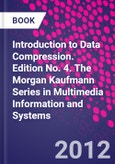Encompassing the entire field of data compression, this book covers lossless and lossy compression, Huffman coding, arithmetic coding, dictionary techniques, context based compression, scalar and vector quantization. New to this fourth edition is a more detailed description of the JPEG 2000 standard as well as speech coding for internet applications. A source code is also provided via a companion web site that gives readers the opportunity to build their own algorithms, choose and implement techniques in their own applications.
This text will appeal to professionals, software and hardware engineers, students, and anyone interested in digital libraries and multimedia.
Table of Contents
1. Introduction2. Lossless Compression
3. Huffman Coding
4. Arithmetic Coding
5. Dictionary Techniques
6. Context Based Compression
7. Lossless Image Compression
8. Lossy Coding
9. Scalar Quantization
10. Vector Quantization
11. Differential Encoding
12. Transforms, Subbands, and Wavelets
13. Transform Coding
14. Subband Coding
15. Wavelet-Based Compression
16. Audio Coding
17. Analysis/Synthesis and Analysis by Synthesis Schemes
18. Video Compression
APPENDIX A: Probability and Random Processes
APPENDIX B: A Brief Review of Matrix Concepts
APPENDIX C: The Root Lattices
Bibliography
Authors
Khalid Sayood Department of Electrical and Computer Engineering, University of Nebraska, Lincoln, Nebraska, USA.Khalid Sayood received his BS and MS in Electrical Engineering from the University of Rochester in 1977 and 1979, respectively, and his Ph.D. in Electrical Engineering from Texas A&M University in 1982. In 1982, he joined the University of Nebraska, where he is the Heins Professor of Engineering. His research interests include data compression, joint source channel coding, and bioinformatics.








